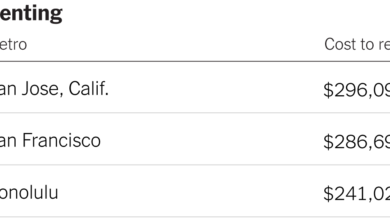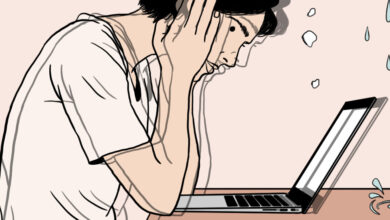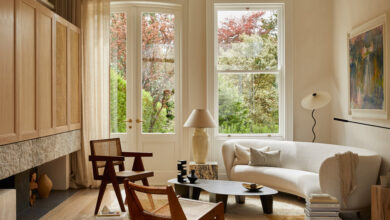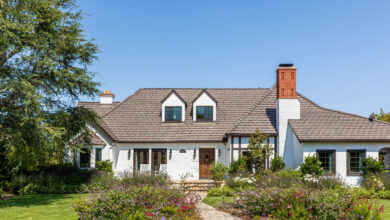House Hunting in Morocco: A Marrakesh Riad for Under $500,000

[ad_1]
A Rebuilt Three-Bedroom Riad in Morocco
$486,000 (400,000 EUROS)
This renovated three-bedroom riad is in the ancient fortified section of Marrakesh, Morocco, known as the medina. A riad is a traditional Moroccan home in which all the rooms are built around an interior courtyard.
The home is situated near the Dar El Bacha, once the palace of Thami El Glaoui, a supporter of the French protectorate, who ruled ruthlessly over the city from 1912 until his death in 1956, the year Morocco gained its independence.
“When the French were setting up their first riads here, this was the area where they went — they wanted to be close to the seat of power,” said Colin Bosworth, the owner of Bosworth Property Marrakesh, which has the listing. “It’s since been the most upmarket part of the medina and has a reputation as being a very safe area.”
The home was rebuilt 12 years ago; all that remains of the original riad, from the early 20th century, are the facade and the kitchen wall, Mr. Bosworth said. But the new design incorporates many traditional Moroccan elements, including Moorish-style archways, decorative plaster work and walls done in tadelakt, a polished, waterproof plaster. The price includes most furnishings.
The main entrance, within a covered medina alleyway, opens into a hall facing a concrete archway leading to the tiled courtyard. The square courtyard has decorative columns, large archways on all sides, and soaring white walls with interior windows lining the upper level. The glass ceiling has panels that fold out to let in fresh air, Mr. Bosworth said.
Facing the courtyard is a long room with gray tadelakt walls that serves as both a sitting room and dining area. A small bar is set off in one corner.
The small kitchen and pantry are off another wall of the courtyard. Bright red cabinetry in an L-shaped preparation area contrasts with the gray walls. A breakfast bar with granite counters faces a wall of open shelving.
The bedrooms, all with en suite baths with Italian showers, are on the second floor. One bedroom has a small balcony overlooking the courtyard; another has an arched window facing the street.
On the third floor is a spa with a hammam (a Turkish bath), a massage room, and a bathroom. Down the hall, a doorway opens onto a patio with a hot tub, summer kitchen and covered sitting area.
A flight of concrete steps on the patio ascends to a large rooftop terrace with panoramic views of the city.
The home is a popular Airbnb rental when its European owners aren’t using it, Mr. Bosworth said. There is no parking area, but taxi service is available nearby. He noted that the easiest method of transport in the medina is bicycle or motor scooter. Marrakesh Menara Airport is about a 20-minute drive.
The walls around the medina and most of the buildings lining its winding alleys are made of an orange-red clay that give Marrakesh its nickname, the Red City. A portion of Dar El Bacha, now entrusted to the National Museum Foundation, was lavishly restored and reopened as the Museum of Confluences in 2017. An elaborate coffeehouse is also housed within the palace.
Market Overview
Before the pandemic cut off tourism to Morocco, which sits just south of Spain in the northwest corner of Africa, a concerted push by the national government to improve infrastructure and promote tourism had been boosting the housing market for several years. Now, after strict lockdowns stymied activity in the spring and summer of 2020, the housing market in Marrakesh, Morocco’s fourth largest city, is poised to pick up again, agents say.
The Moroccan government recently suspended all flights to and from most countries during the several weeks of Ramadan, to prevent an influx of people for the religious holiday, but the restriction is expected to be lifted by June, said Maud Faujas, director of Emile Garcin Marrakesh.
Alex Peto, a partner at Kensington Luxury Properties, the Morocco affiliate of Christie’s International, said he expects the market to gather considerable speed come September, after the hot summer is over and vaccinations are more widespread.
“Back in January, February of 2020, it was the first time in nearly a decade that it was looking like things were really starting to bubble,” he said. “Then Covid came along.”
As of May 10, Morocco had reported 513,864 cases of Covid-19 and 9,072 deaths, according to the New York Times coronavirus world map. Flights from the United States to Morocco are available but remain very limited. Travelers entering Morocco must present negative results of a Covid-19 test conducted less than 72 hours before boarding.
Mr. Peto said the continued loosening of travel restrictions should pull the stops out of the market. “The number of inquiries are the same as last year,” he said, “and there are a lot of people who keep saying, ‘As soon as the borders reopen, I’m on the first plane.’”
During the fourth quarter of 2020, residential prices were up 0.8 percent across Morocco compared with Q4 2019, according to data from Bank Al-Maghrib, Morocco’s central bank. In Marrakesh, fourth-quarter prices were up 1.1 percent over the previous quarter, and transactions shot up 47 percent.
There is currently some distress selling in the small guesthouse market — five- to seven-bedroom, family-owned operations, Mr. Bosworth said. The absence of tourism has hit that sector hard, resulting in price reductions of 30 to 40 percent.
But prices are otherwise stable, as buyer interest from Europe has picked up significantly, Ms. Faujas said. Riads in Marrakesh’s densely packed medina are popular with holiday-home buyers because they are reasonably priced, starting at around 250,000 euros ($304,000), and a reliable source of rental income, she said. (While the pricing of listings is typically in euros because of the prevalence of European buyers, final transactions are done in Moroccan dirhams.)
“Even a small place you can rent for 200 to 250 euros a night,” she said. “It’s the best thing to buy as an investment.”
Villas on the 15 18-hole golf courses around Marrakesh typically average around 1 million euros ($1.22 million), though they can be had for as little as 500,000 ($608,000). The palatial homes in the desert suburb of Palmeraie, where many wealthy Moroccan families live, start at around 3 million euros ($3.6 million), she said.
Who Buys in Marrakesh
Most foreign buyers are from Europe, with France leading the way. “We’re three hours from Paris and Geneva, two hours from Madrid,” Mr. Bosworth said.
More recently, investors from Mexico, Singapore and the United States have been showing interest, recognizing that European tourists are likely to flood Marrakesh once the pandemic subsides, he said.
In addition, Morocco’s decision last year to begin normalizing relations with Israel, and the planned launch of direct flights between the two countries, has resulted in more interest in holiday homes from Jewish Moroccans living elsewhere, Ms. Faujas said.
Buying Basics
There are no restrictions on foreign buyers in Morocco. A notary handles the transaction and is responsible for performing all due diligence. Foreign buyers paying in cash must register their money with the Foreign Exchange Office, which can be done through the notary
The agent’s commission is 6 to 8 percent, split between buyer and seller, Ms. Faujas said.
Websites
Languages and Currency
Arabic and French; Moroccan dirham (1 dirham = $0.11)
Taxes and Fees
Closing costs, including fees for the land registry, stamp duty, notary and agent’s commission, typically amount to about 10 percent of the purchase price, Mr. Bosworth said. A government incentive program for buyers purchasing private residences up to around $400,000 halves land registry fees, dropping closing costs to about 8 percent, he said.
City taxes on this home are about $400 a year.
Contact
Colin Bosworth, Bosworth Property Marrakesh, 011-212-658-025028; bosworthpropertymarrakech.com/
For weekly email updates on residential real estate news, sign up here. Follow us on Twitter: @nytrealestate.
[ad_2]
Source link






